7 Arietis is a binary star system in the northern constellation of Aries. 7 Arietis is the Flamsteed designation. The pair have a combined apparent visual magnitude of 5.76, making it faintly visible to the naked eye from dark suburban skies. Based upon an annual parallax shift of 5.39 mas, it is approximately 600 light-years distant from the Earth, give or take a 30 light-year margin of error. It is drifting further away from the Sun with a radial velocity of +16 km/s.
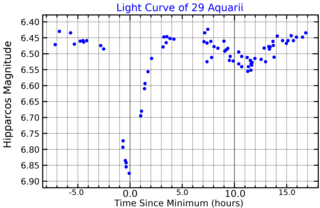
29 Aquarii is a binary star system located around 590 light years away from the Sun in the equatorial constellation of Aquarius. 29 Aquarii is the Flamsteed designation; the system also bears the variable star designation DX Aquarii. It is a challenge to view with the naked eye, appearing as a dim star with a combined apparent visual magnitude of 6.39. The system is moving further from the Earth with a heliocentric radial velocity of about +15 km/s.

DV Aquarii is a binary star system in the zodiac constellation of Aquarius. It has a peak apparent visual magnitude of 5.89, which is bright enough to be visible to the naked eye. The distance can be estimated from its annual parallax shift of 11.2 mas, yielding a separation of 291 light years.

CT Chamaeleontis (CT Cha) is a T Tauri star - a primary of the star system in the constellation of Chamaeleon. It has an apparent visual magnitude which varies between 12.31 and 12.43. The star is still accreting material at rate 6×10−10 M☉/year.

Z Chamaeleontis is a dwarf nova variable star system approximately 377 light-years away from the Sun, where two stars orbit each other every 1.78 hours. The system comprises an eclipsing white dwarf and red dwarf and possibly a yet unconfirmed third low-mass substellar companion.

Epsilon Chamaeleontis, Latinized from ε Chamaeleontis, is a triple star located in the southern circumpolar constellation Chamaeleon. The primary and secondary have apparent magnitudes of 5.33 and 6.02, making them visible to the naked eye. Hipparcos parallax measurements place the system at a distance of 360 light years and is currently receding with a heliocentric radial velocity of 13 km/s.

Zeta Chamaeleontis, Latinized from ζ Chamaeleontis, is a star located in the constellation Chamaeleon. Located around 570 light-years distant, it shines with a luminosity approximately 522 times that of the Sun and has a surface temperature of 15,655 K. South African Astronomer A.W.J. Cousins noted it to vary between magnitudes 5.06 and 5.17 in 1960. It was classified as a Beta Cephei variable in the Hipparcos and Tycho Catalogues, with a period of 1.07 days, before being reclassified as a slowly pulsating B star in the 2011 version. It is also an eclipsing binary star, with a period of 2.7 days.

Eta Chamaeleontis, Latinized from η Chamaeleontis, is a star in the constellation Chamaeleon. It has an apparent magnitude of about 5.5, meaning that it is just barely visible to the naked eye. Based upon parallax measurements, this star is located some 325 light-years light years away from the Sun.
μ1 Chamaeleontis, Latinized as Mu1 Chamaeleontis, is a single star in the southern circumpolar constellation Chamaeleon. It is dimly visible to the naked eye with an apparent visual magnitude of 5.53. Based upon parallax measurements, it is located approximately 403 light-years away from the Sun. The radial velocity is poorly constrained, but it appears to be drifting further away at the rate of about 16 km/s

Chi2 Hydrae, Latinised from χ2 Hydrae, is a binary star system in the equatorial constellation of Hydra. Based upon an annual parallax shift of 4.6 mas as seen from Earth, it is located roughly 685 light years from the Sun. It is visible to the naked eye with a combined apparent visual magnitude of about 5.7.

ZZ Boötis is a star system in the constellation Boötes. It varies from magnitude 6.79 to 7.44 over five days. Based on its parallax, measured by the Gaia spacecraft, it is about 350 light-years away.
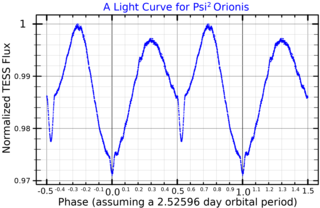
Psi2 Orionis a binary star system in the equatorial constellation of Orion. It has an apparent visual magnitude of 4.6, indicating that it is visible to the naked eye. Based upon an annual parallax shift of 2.87 mass, it is roughly 1,100 light years distant from the Sun.
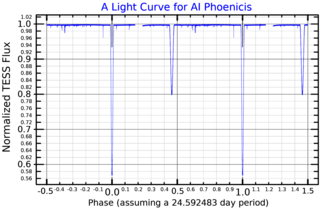
AI Phoenicis is a variable star in the constellation of Phoenix. An Algol-type eclipsing binary, its apparent magnitude is constant at 8.58 for most of the time, sharply dropping to 9.35 during primary eclipse and to 8.89 during secondary eclipse. The system's variability was discovered by W. Strohmeier in 1972. From parallax measurements by the Gaia spacecraft, the system is located at a distance of 560 light-years from Earth, in agreement with earlier estimates based on its luminosity.

HS Hydrae is a triple star system in the equatorial constellation of Hydra. The inner pair were an eclipsing binary during the period 1920 until 2019, with HS Hya being the variable star designation. With a base apparent visual magnitude of 8.08, HS Hya is too dim to be viewed with the naked eye. During the primary eclipse, the magnitude dropped to 8.61; the secondary eclipse lowered the magnitude to 8.55. Based on parallax measurements, the system is located at a distance of approximately 335 light years from the Sun. It is drifting closer with a mean radial velocity of −7 km/s.
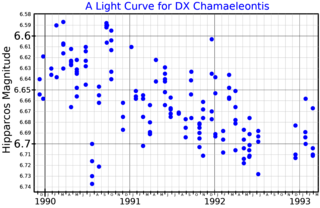
HD 104237 is a candidate multiple star system in the southern constellation of Chamaeleon. It has the variable star designation DX Chamaeleontis, abbreviated DX Cha; HD 104237 is the stellar designation from the Henry Draper Catalogue. The system is dimly visible to the naked eye with an apparent visual magnitude that ranges from 6.59 down to 6.70. It is located at a distance of approximately 348 light-years from the Sun based on parallax measurements. The system is positioned just 2′ to the north-east of the 5th magnitude star Epsilon Chamaeleontis, and is a member of the ε Cha association of co-moving stars.

HU Tauri is a tight binary star system in the equatorial constellation of Taurus. It is an eclipsing binary, which means that the member stars periodically eclipse each other every 2.056 days. They have a combined apparent visual magnitude of 5.85, which is bright enough to be dimly visible to the naked eye. During the primary eclipse, the magnitude drops to 6.68, while the secondary eclipse decreases the magnitude to 5.91. The distance to this system, based on parallax measurements, is approximately 414 light years.
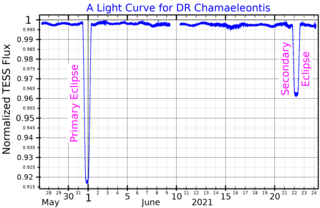
DR Chamaeleontis, also known as HD 93237, is a star located in the southern circumpolar constellation Chamaeleon. The system has an average apparent magnitude of 5.97, allowing it to be faintly visible to the naked eye. DR Cha is located relatively far at a distance of 1,060 light years based on Gaia DR3 parallax measurements, but is receding with a poorly constrained heliocentric radial velocity of 18 km/s.
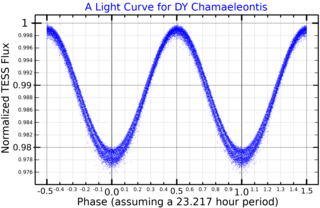
HD 118285, also known as HR 5115, is a variable star located in the southern circumpolar constellation Chamaeleon. DY Chamaeleontis is its variable star designation. It has an average apparent magnitude of 6.32, placing it near the limit for naked eye visibility. The object is located relatively far at a distance of 864 light years based on Gaia DR3 parallax measurements but is receding with a heliocentric radial velocity of 18 km/s. At its current distance, HD 118285's brightness is diminished by 0.58 magnitudes due to interstellar dust.

HD 75747, also known as HR 3524 or RS Chamaeleontis, is a binary star located in the southern circumpolar constellation Chamaeleon. It has an average apparent magnitude of 6.05, making it barely visible to the naked eye. The system is located relatively close at a distance of 322 light years based on Gaia DR3 parallax measurements but is receding with a somewhat constrained heliocentric radial velocity of 16.1 km/s. It has an absolute magnitude of +1.21.

T Chamaeleontis, also known as HIP 58285, is a T Tauri star located in the southern circumpolar constellation Chamaeleon. It has an apparent magnitude that ranges from 10.05 to 14.50, which is below the limit for naked eye visibility. Gaia DR3 parallax measurements place the object 335 light years away and it is currently receding with a heliocentric radial velocity of 13.8 km/s. At its current distance, T Cha's average brightness is diminished by 0.31 magnitudes due to extinction from interstellar dust. It has an average absolute magnitude of +6.55.

















